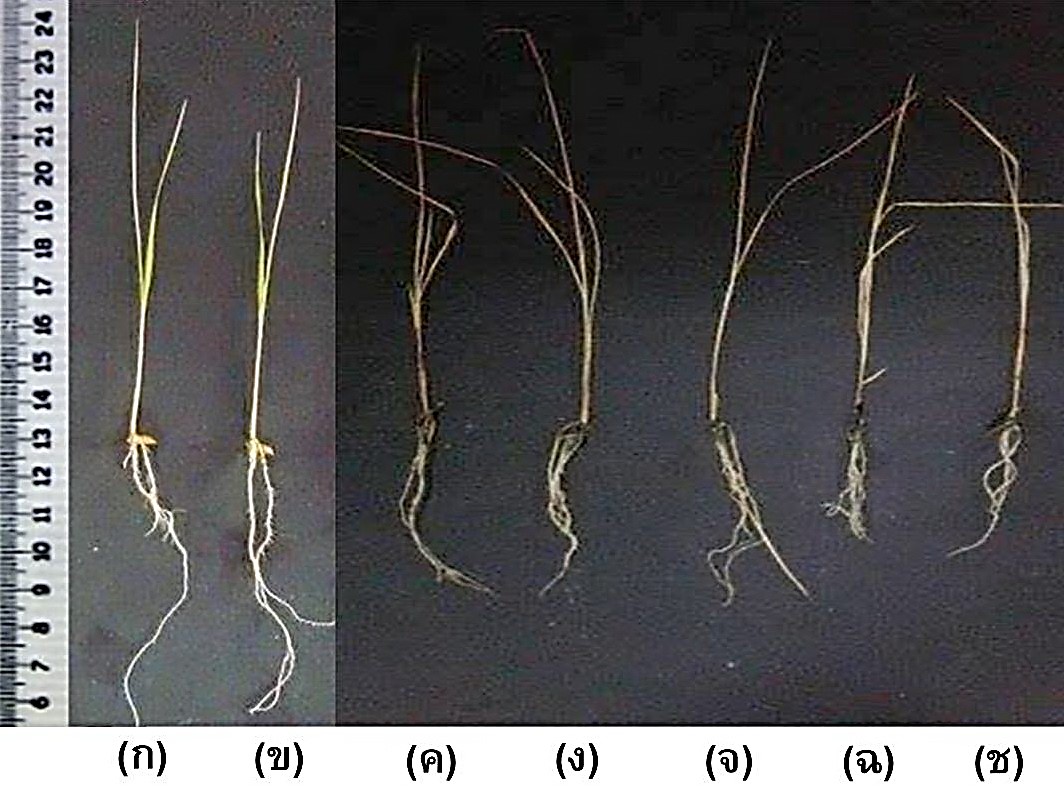ศักยภาพของไซยาโนแบคทีเรียออสซิลลาทอเรีย SWU 121 ในการส่งเสริมการเจริญเติบโตของข้าวภายใต้ภาวะเครียดจากเกลือ
Main Article Content
Abstract
Amorn Poolsawasdi, Sakina Yadee, Bongkoj Boonburapong and Surasak Laloknam
รับบทความ: 11 กรกฎาคม 2558; ยอมรับตีพิมพ์: 9 พฤศจิกายน 2558
บทคัดย่อ
งานวิจัยนี้มีวัตถุประสงค์เพื่อ 1) ศึกษาผลของความเค็มที่มีผลต่อการเจริญของไซยาโนแบคทีเรียออสซิลลาทอเรีย SWU 121 ที่เพาะในอาหารเลี้ยงเชื้อเหลวสูตร BG11 ที่ระดับความเข้มข้นของโซเดียมคลอไรด์ 0 5 10 15 20 25 30 และ 60 ppt ติดตามการเจริญของไซยาโนแบคทีเรียด้วยการวัดค่าการดูดกลืนแสงที่ความยาวคลื่นแสง 750 nm และวัดปริมาณคลอโรฟิลล์ด้วยเครื่องสเปกโตโฟโตมิเตอร์ 2) ศึกษาผลของความเค็มที่มีผลต่อการเจริญเติบโตของข้าวเจ้าสายพันธุ์ขาวดอกมะลิ 105 ที่ปลูกในอาหารเหลวสูตร Hoagland ที่ระดับความเข้มข้นของโซเดียมคลอไรด์ 0 5 10 15 20 25 และ 30 ppt จากนั้นติดตามการเจริญเติบโตโดยวัดความยาวรากและลำต้น น้ำหนักสดของรากและลำต้น น้ำหนักแห้งของรากและลำต้น และปริมาณคลอโรฟิลล์ และ 3) ศึกษาผลของไซยาโนแบคทีเรียออสซิลลาทอเรีย SWU 121 ต่อการเจริญเติบโตของข้าวเจ้าสายพันธุ์ขาวดอกมะลิ 105 ที่ปลูกในอาหารเหลวสูตร Hoagland ที่ระดับความเข้มข้นของโซเดียมคลอไรด์ 5 ppt ผลการ ศึกษา พบว่า ภาวะที่ไซยาโนแบคทีเรียออสซิลลาทอเรียเจริญได้ดีที่สุด คือ ที่ระดับความเข้มข้นของโซเดียมคลอไรด์ 0 ppt และสามารถทนความเค็มได้ 20 ppt ในขณะที่ข้าวเจ้าสายพันธุ์ขาวดอกมะลิ 105 เจริญได้ดีที่สุดที่ระดับความเข้มข้นของโซเดียมคลอไรด์ 0 ppt และสามารถทนความเค็มได้ 5 ppt เป็นระยะเวลา 21 วัน จากนั้นนำต้นข้าวพันธุ์ขาวดอกมะลิ 105 ปลูกในอาหารเหลวสูตร Hoagland ที่ระดับความเข้มข้นของโซเดียมคลอไรด์ 0 ppt และ 5 ppt ร่วมกับการเพาะเลี้ยงไซยาโนแบคทีเรียออสซิลลาทอเรีย SWU 121 พบว่า ข้าวเจ้าสายพันธุ์ขาวดอกมะลิ 105 ที่ปลูกร่วมกับการเพาะเลี้ยงไซยาโนแบคทีเรียภายใต้ภาวะที่มีความเข้มข้นของโซเดียมคลอไรด์ 5 ppt สามารถเจริญเติบโตได้ตลอดระยะเวลาของการติดตามผล 28 วัน จากผลการศึกษาอธิบายได้ว่า ไซยาโนแบคทีเรียน่าจะมีกลไกในการส่งเสริมการเจริญเติบโตของข้าวภายใต้ภาวะที่มีความเครียดจากเกลือ
คำสำคัญ: ข้าวพันธุ์ขาวดอกมะลิ 105 ภาวะที่มีความเข้มข้นของโซเดียมคลอไรด์ ไซยาโนแบคทีเรีย
Abstract
This research aimed to: 1) the effect of salinity on the growth of cyanobacterium Oscillatoria sp. SWU 121 in BG11 broth supplemented with sodium chloride concentration ranging of 0, 5, 10, 15, 20, 25, 30 and 60 ppt. The growth rate was measured by a spectro-photometer at wave length of absorbance at 750 nm and chlorophyll contents. 2) The effect of salinity on the growth of Jasmin rice variety Khao Dok Mali 105 in the Hoagland liquid medium supplemented with sodium chloride concentration ranging of 0, 5, 10, 15, 20, 25 and 30 ppt. The growth of rice was determined by measuring the length of the roots and stems, the fresh weight of roots and stems, the dry weight of the roots and stems, and the chlorophyll contents. 3) The effect of cyanobacterium on the growth of Jasmin rice variety Khao Dok Mali 105 at sodium chloride concentration of 0 and 5 ppt, and the growth of rice was determined. The results showed that Oscillatoria sp. SWU 121 had optimal growth rate at the condition without sodium chloride. Oscillatoria sp. SWU 121 could tolerate salinity at limitation of growth at 20 ppt. The Jasmin rice variety Khao Dok Mali 105 could tolerate salinity at 5 ppt for 21 days. The Jasmin rice variety Khao Dok Mali 105 grown with cyanobacteria in the Hoagland liquid medium at the concentration of sodium chloride at 5 ppt were determined. Thus, the Jasmine rice variety Khao Dok Mali 105 grown with Oscillatoria sp. SWU 121 supplemented with sodium chloride at 5 ppt can grow over a period of 28 days. These finding revealed that cyanobacteria might have mechanisms to promote growth of rice under salt stress condition.
Keywords: Jasmine rice variety Khao Dok Mali 105, Salt stress conditions, Cyanobacteria
Downloads
Article Details

This work is licensed under a Creative Commons Attribution-NonCommercial 4.0 International License.
References
Bualuang, A., Kongwithtaya S., and Laloknam S. (2013). Application of Micro-Alga. Journal of Research Unit on Science, Technology and Environment for Learning 4(1): 72–79. (in Thai)
Danyuttasilp, Y., and Laloknam S. (2013). Increasing of oxygen contents in waste water from Saen Saeb canal under laboratory room using filamentous cyanobacteria. Advanced Science Journal 13(2): 24–34. (in Thai)
Hoagland, D. R., and Arnon, D. I. (1950). The Water Culture Method for Growing Plants Without Soil. California Agricultural Experiment Station. N0.347. Berkeley, CA: The College of Agriculture: University of California.
Kanchitanurak P. (2013). Effect of salt stress on ion contents and osmpro-tectant in cyanobacteria. M.Sc. Thesis in Biology. Bangkok: Srinakharinwirot University. (in Thai)
Keokene T., and Pattanagul, W. (2006). Effects of drought induced and salinity induced water deficition on some physiological characteristics and carbohydrate metabolism in rice seedlings (Oryza sativa L.). KKU Research Journal 11(4): 260–268. (in Thai)
Laloknam S., and Boonburapong B. (2011). Potential of cyanobacteria in Thailand. Journal of Research Unit on Science Technology and Environment for Learning 2(2): 149–154. (in Thai)
Laloknam, S., Bualuang, A., Boonburapong, B., Rai, V., Takabe, T., and Incharoensakdi, A. (2010). Salt stress induced glycine-betaine accumulation with amino and fatty acid changes in cyanobacterium Aphanothece halophytica. Asian Journal of Food and Agro-Industry. 3(1): 25–34.
Laloknam, S., Kanchitanurak, P., Boonburapong B., Rai, V., Kongwitthaya, S. (2014). Inorganic and organic compounds of freshwater filamentous cyanobacteria under normal and salt stress conditions. Journal of Chemistry and Chemical Engineering 8: 1059–1067.
Meekaew, W., Kanthaprab, N., and Laloknam, S. (2010). Adaptation of plant under salinity. Advanced Science Journal 10(2): 28–37. (in Thai)
Peerapornpisal, Y. (2005). Freshwater Algae in Northern Thailand. Chiang Mai: Chotana Print, Chiang Mai. (in Thai)
Peerapornpisal, Y. (2006). Phycology. 2nd ed. Chiang Mai: Department of Biology, Faculty of Science, Chiang Mai University. (in Thai)
Sinha, A., and Srivastava, M. (2010). Biochemical changes in mungbean plants infected by mungbean yellow mosaic virus. International Journal of Virology 6(3): 150–157.
Teerapongthanakorn S., and Lerdsupawithna-pha, B. (2009). The comparative morphology, anatomy and physiology of salt-tolerant and landrace rice cultivars under NaCl stress. Ubon Ratchathani Univer-sity Journal 11(4): 1–10. (in Thai)
The Center for International Trade Studies [UTCC]. (2013). The future of Thai rice. Available from http://www.democratic-army.com/index.php/12-april-2013/17-2013-04-30-00-31-55, June 12, 2015.
Trakoonkamnerd, C., Intham, P., Jumrusruk, W., Kongchana, S., Danyuttasilp Y., Sirisopana, S., and Laloknam, S. (2012, May). Increasing the amount of oxygen in the water from khlong Saen Saeb by cyanobacterium Oscillatoria sp. Proceeding of The 6th Srinakharinwirot University National Conference. Bangkok: Srinakharinwirot University. (in Thai)
